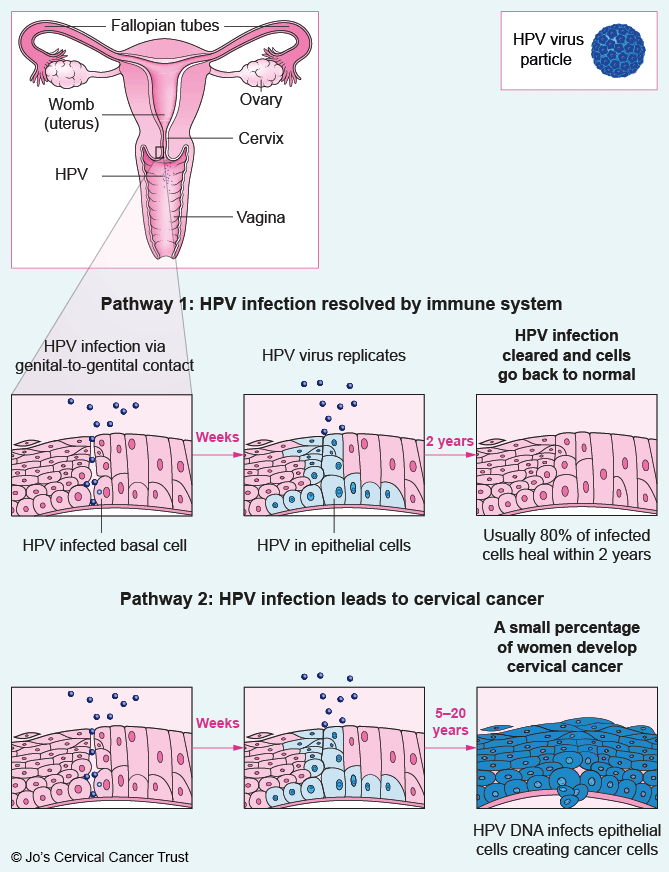
Infectious Agents






Human T-Lymphotrophic virus Type-1
Human T-lymphotropic virus type-1 is a virus that is known to be present in most leukemia cancers. HTLV-1 is a retrovirus that is transmitted through intimate contact such as breast feeding, semen, unscreened blood, or needle usage. For this retrovirus, HTLV-1 genomic RNA is copied into DNA by reverse transcriptase before viral proteins of HTLV-1 induces carcinogenesis. A protein of HTLV-1, TAX, interacts with more than a hundred cellular proteins that are involved with the stimulating cell growth, inhibiting DNA repair, and altering the cell cycle. By activating cyclin-dependent kinases. This molecule activates the host genes of using transcription factors NF-kB and AP1, and interfere with tumor suppressor genes causing cell proliferation, which can lead to leukemia.
Human Papilloma Virus
Epstein-Barr virus is a DNA virus that effects B cell lymphoproliferative diseases and nasopharyngeal carcinoma. Evidence of studies show that EBV has the ability to transform lymphoid cells in culture and as well as being present in all cases of nasopharyngeal carcinomas that have EBV infections. EBV encodes several viral proteins that affect host gene expression such It has the ability to activate nuclear transcription factor known as NF-kB, which are important factors in activating growth pathways and anti-apoptotic pathways.
HPV has a strong relation to cervical cancer. Genital HPV is one of the most common sexually transmitted viral infections that increase as the number of sexual partner’s increase. This virus has access to proliferating cervical epithelium. It uses entry ways created by micro-erosion of overlaying cell layers to rease the basal layer of the epithelium. This is where stem cells and progenitor cells reside.
Hepatitis B Virus is a known virus that is linked to liver cancer. HBV is a virus that causes immune responses that results in liver necrosis, inflammation, and regeneration. Hepatitis B is known to cause increased proliferation in cells and oxidative stress from inflammation causing to oncogenic mutations. HBV plays an important role the development of hepatocellular carcinoma and HBV induced carcinogenesis as well as inducing liver cancer. Studies with mice have shown that HBV activates proto-oncogenes by signaling cascades such as kinase cascades by interacting with NF-kB and binding to p53. When it binds to p53, p53 functions are inactivated, causing it to lose its functions, resulting in cancer.
Kaposi’s sarcoma-associated herpesvirus is a DNA virus that is linked with vascular tumors. This virus is known to infect circulating endothelial precursor cells or endothelial cells. KSHV is known to aid in tumorigenesis through several mechanisms by thriving cell proliferation and preventing apoptosis. The virus produces several products such as viral cyclin, viral anti-apoptotic proteins and viral proteins called LANA that interferes with the functions of RB and p 53 genes. LANA targets tumor suppressor proteins similar to the ones associated with HPV viral proteins.
Helicobacter pylori is a bacterium that induces chronic inflammation in the stomach, initiating carcinogenesis, specifically gastric carcinogenesis. Gastric cancer is known to develop when Helicobacter pylori is present, depending on the strain of the bacterium. High risk strains of H. pylori code for a protein known as cytotoxin- associated Antigen (CagA) which is seen in predominant regions in gastric cancer. Phosphorylated CagA binds with other proteins such as SHP-2 causing them to be activated, leading to an imbalance of mitogenic signals. H. pylori also induces chronic inflammation and stem cell recruitment. H. pylori sends proteins to ells that induce pro-inflammatory mediators in the NF-kB pathway, causing DNA methyltransferases. The inflammation caused by H. pylori causes oxidative stress, and ultimately increasing the rate of mutations, leading to cancer progression.
Epstein-Barr Virus
Hepatitis B Virus
Kaposi's sarcoma- associated herpesvirus
Helicobacter pylori





